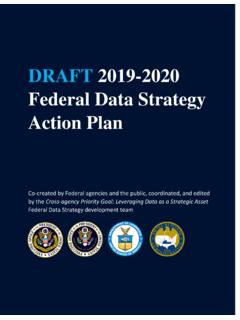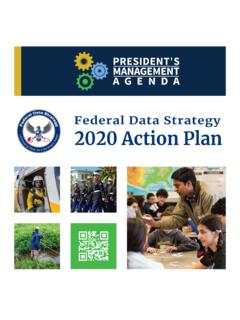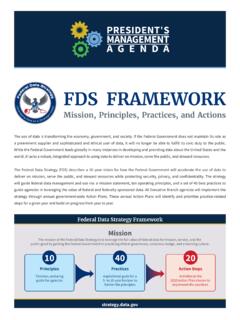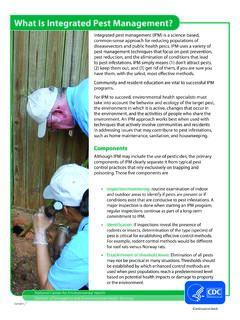Transcription of Federal Data Strategy 2021 Action Plan
1 Federal Data Strategy 2021 Action Plan Foreword To account for the changing role of data and meet the needs of democracy, the Federal government created a coordinated and integrated Federal Data Strategy (FDS). Leaders from the Office of Management and Budget, Office of Science and Technology Policy, Department of Commerce, and Small Business Administration built an interdisciplinary team that worked with private industry, academia, civil servants, and the public to build a robust integrated approach to managing and using data. The result was a Strategy that plans for agencies' use of data for a variety of critical purposes: to generate evidence-based policy, to deliver on mission, to serve the public, and to steward resources. At the same time, the FDS emphasizes the vital need to protect security, privacy, and confidentiality. The 2021 Action Plan identifies specific actions to be taken in support of the FDS, while also recognizing that 2021 is a transition year for the Executive Branch.
2 Given the timing of the release of this 2021 Action Plan in the context of a transition year and with significant efforts underway across agencies on the Administration's immediate priorities,1 agencies may only begin working on toward the Plan's milestones before the end of calendar year 2021. Nevertheless, this Action Plan establishes these aspirational milestones in order to encourage agencies to make steady progress on the Plan's actions and milestones. In doing so, agencies will enhance their ability to use data to achieve their missions and deliver to the American public. 1. The Biden-Harris Administration Immediate Priorities are available at Federal Data Strategy 2021 Action Plan Contents Introduction .. 1. 2020 Action Plan Successes and Lessons Learned .. 3. Agency Actions .. 6. Community of Practice and Shared Solution Actions .. 13. Looking Ahead .. 19. The 2021 Action Plan was coordinated and edited by the Federal Data Strategy development team.
3 Federal Data Strategy 2021 Action Plan iii Introduction On June 4, 2019, the Office of Management and Budget published Memorandum M-19-18, Federal Data Strategy A. Framework for Consistency, which provided a Mission Statement, Principles, and Practices to provide a government- wide vision for how agencies should manage and use Federal data by 2030. Specifically, the FDS calls for the Federal government to replicate, accelerate, and scale leading practices related to government data, including steps to: Provide consistent, reliable and privacy-preserving access to Federal government data to the public, businesses, and researchers for commercial and other public purposes;. Fill gaps in government capacity and knowledge;. Increase the sharing and use of data for Federal decision-making and operational needs;. Make Federal data more findable and discoverable through rich descriptions and metadata;. Utilize data and operational maturity models and evidence-based planning assessments.
4 Provide data-management tools and protocols for secure data access for state, local, tribal, and territorial governments; and Plan for secondary data uses from the outset, through re-identification risk assessments, stakeholder engagement, and sufficient information to assess fitness for use. M-19-18 calls for annual government-wide Action Plans to guide Federal agency implementation of the FDS, and to identify and prioritize practice-related steps for a given year, along with target timeframes and responsible entities. 2. This approach balances long-term goals stretching across budgets and administrations with short-term flexibility to adjust for emerging national priorities, new legislation, and data maturity levels, needs, and capabilities that vary across agencies. The 2021 Action Plan was developed in consultation with an interagency, interdisciplinary working group and the Chief Data Officer (CDO) Council Executive Committee. To achieve the 2030 Vision of the FDS, annual Action Plans follow an incremental maturity ladder that generally moves from: Foundational activities of governance, planning, and infrastructure (~2020-2022), to Enterprise activities of standards, budgeting, and coordination (~2023-2025), to Optimized activities of self-service analytics (~2026-2028), and finally, to Data-Driven activities of proactive evidence-based decisions and automated data improvements (~2029.)
5 And forward) (see Figure 1). 2. The Federal Data Strategy is available at Federal Data Strategy 2021 Action Plan 1. Figure 1 depicts what the FDS as whole can achieve by 2030 to advance data-driven government. Some agencies (or their components) may be further along the ladder in 2021, and many Federal programs and offices are actively engaging in Data-Driven activities today. Agencies that can make progress more quickly than outlined in the Strategy are encouraged to continue promoting enhancement opportunities. The goal of the FDS, however, is to ensure that these activities do not happen in an ad hoc way, but rather are integrated into agency culture and become standard practice across all Federal government programs. Figure 1. Federal Data Strategy Data Driven 10-Year Vision Activities Optimized Proactive evidence-based Activities decisions, automated data improvements Enterprise Self-service analytics Activities Foundational Standards, budgeting, coordination Activities Governance, planning, infrastructure 2020 2021 2022 2023 2024 2025 2026 2027 2028 2029 2030.
6 The 2021 Action Plan builds on the outcomes of the 2020 Action Plan and reinforces the activities of data governance, planning, and infrastructure. During 2021, CDOs will continue to grow in their new capacity and lead each agency to fulfill ambitious but achievable goals to better serve the public. Federal Data Strategy 2021 Action Plan 2. 2020 Action Plan Successes and Lessons Learned Major successes of the 2020 Action Plan3 in the areas of foundational governance, planning, and infrastructure activities lay the groundwork for implementing the FDS by 2030. Governance The 2020 Action Plan empowered CDOs to develop their agencies' internal governance structures for the management and use of data. At each agency, the CDO worked across business lines to establish a Data Governance Body and began critical steps to build data Strategy road maps, develop plans for enterprise data assets and infrastructure capital planning, and adopt master data-management programs.
7 Collectively, the CDOs formed the first-ever Federal Chief Data Officer (CDO) Council to promote best practices in leveraging data for decision-making and operations. In addition to its regular meetings, the CDO Council encouraged a vibrant learning community by holding regular information sharing sessions between CDOs on best practices to fulfill the FDS. Additionally, the CDO Council began working collaboratively to solve emerging cross-cutting data challenges, such as through the creation of the COVID-19 Working Group. The establishment of responsive and effective governance structures at individual agencies and across the entire Federal enterprise provides the framework for continued government success for the 10-year FDS vision. Planning Throughout 2020, CDOs examined their agencies' mission requirements, infrastructure, and workforce in order to develop effective plans for the future. Specifically, agency CDOs, working with Evaluation Officers (EO) and Statistical Officials (SO), helped to identify and determine how to access the data needed to answer priority agency questions.
8 Agencies also selected and implemented operational maturity assessment models to establish a baseline for future improvements related to their data infrastructure. Finally, agencies assessed the data literacy and skills of their current staff to determine what gaps must be bridged to ensure the workforce can implement data-driven and evidence- building activities. 3. The 2020 Action Plan is available at Federal Data Strategy 2021 Action Plan 3. Both the Chief Information Officer (CIO) Council and CDO Council have begun creating tools to assist agencies with increasing their staff data skills, and the Interagency Council on Statistical Policy (ICSP) continues its training and mentoring programs. In addition, the General Services Administration (GSA) issued a Staff Data Skills Catalog of agency program offerings as highlighted in the 2020 Action In 2020, agencies nominated 61 Federal employees for an interagency pilot in data upskilling, and this cohort completed their capstone projects and graduated from the program in April 2021.
9 Additionally, the CIO Council released materials for agencies to build their own data-science training program. Likewise, the CDO Council established a Data Skills Development Working Group. The CDO Council is exploring joint hiring initiatives with the United States Digital Service to improve access to professionals with advanced data-science skills. The 2020 Action Plan also tracked progress made by other Federal councils to plan interagency data-related initiatives. For example, Federal councils launched planning products to improve financial data standards and established a geospatial data infrastructure strategic plan. The Federal government also investigated access and quality topics associated with artificial intelligence (AI) research and development. Infrastructure An agency's data inventory establishes the foundational structure for data access and can allow for further technological innovation, policymaking insights, and economic development.
10 Agencies made significant progress in indexing data assets in their inventories on , and identified certain data assets related to a broad range of critical issues such as COVID-19 and AI research and development. The 2020 Action Plan also involved several initiatives to establish uniform resources, pilots, and tools for the benefit of all agencies. served as a hub of information to assist all Federal agencies in building a data-driven Specifically, newly developed guides that CDOs can access and use were added to the site, such as a Data Skills Catalog, Data Ethics Framework, Data Protection Toolkit, and Data Quality Toolkit. In other cases, Federal organizations piloted new infrastructure to improve the management of and access to data through a One-Stop Researcher Application, an Information Collection Review Tool from the Department of Education, and an Enhanced Data Management Tool, incorporating user input throughout the development of these pilots.









